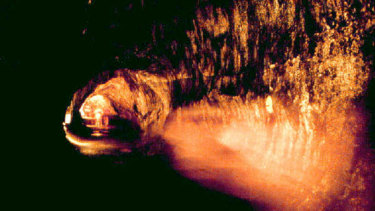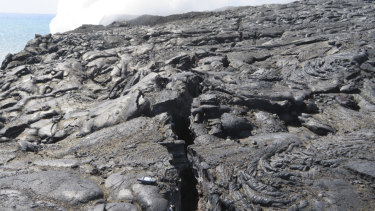Home » World News »
Hawaiian man dies after falling into a lava tube hidden in his backyard
In concrete jungles, there's the fear of falling through a grate in the pavement. In parts of Hawaii, there are lava tubes.
They form during volcanic eruptions, starting as rivers of lava and flowing downstream as they branch out into smaller channels like the roots of a tree. Then the exposed lava cools and hardens. A roof forms over the river, allowing the lava beneath it to go on flowing for months until it slows and drains and hollows – becoming a tube.
A lava tube on Hawaii’s Big Island.
Despite their ubiquity on Hawaii's Big Island, it's rare for someone to fall into a lava tube, experts say. But it can happen.
And on Monday, police said it happened to an elderly man – in his own backyard in Hilo, on the island's east coast.
The man, named by Big Island Now as Robert Hisashi Nishimoto, 71, appeared to be trimming branches in his yard when he fell "through a soft area of ground" into a hidden lava tube and died, police said on Wednesday.
Police arrived at Nishimoto's home to perform a welfare check on Monday after one of his friends called to report him missing, Big Island Now reported. Rescue personnel found him at the bottom of the 60-centimetre-wide lava tube, 6.5 metres below ground.
a crack that has developed near the site of a lava stream pouring out of a lava tube on the sea cliff at the Kamokuna ocean entry at the Hawaii Volcanoes National Park on the Big Island of Hawaii.Credit:US Geological Survey via AP
He was take to hospital, where he was pronounced dead. An autopsy found he died "as a result of injuries consistent with falling" and police said no foul play was suspected.
It's unclear how he fell into the lava tube. Ken Hon, a vulcanologist at the University of Hawaii at Hilo, told The Washington Post he suspects the hole was already there and that the man most likely just didn't see it – possibly because it was covered in overgrowth. Plenty on the island are, Hon said. The tubes are everywhere: in neighbourhoods and under streets, in forests and national parks like an underground cave system right beneath your feet.
"You could be standing on one and not even know it," Hon said.
The holes are called "skylights", he said. "That's where a thin part of the roof collapses, so you'll have a hole into the lava tube. If you think of a skylight in a house, it's just a window up in the roof. The skylight is a hole in the roof of the cave."
Hon and two other scientists told the Post believe there's a good possibility the lava tube formed during the massive 1880-1881 eruption of the Mauna Loa volcano. The lava flowed for months and kilometres, threatening the town of Hilo as it inched closer. People prayed to God and Pele, the Hawaiian goddess of volcanoes, asking for the lava to stop, building ditches and blasting dynamite to try to divert its flow, the National Park Service said.
More than nine months later, once the rivers of lava stopped, the result was the Kaumana Caves – an eight-kilometre network of lava tubes.
Tom Shea, a vulcanology professor at the University of Hawaii at Manoa, said tube systems are typically structured "in a treelike fashion".
The primary tube is the trunk, sometimes stretching nine metres or more in diameter, while secondary tubes are like branches, growing smaller with distance, he said.
"The difficulty is, therefore, that even if the main tube location is known, there are still hazards associated with secondary tube branches," he said.
The victim most likely fell into "the prolongation of the well known Kaumana Caves on the west side of Hilo," Shea said.
Shea said the lava tubes were a "major issue for land stability" on the Big Island, and that geological surveys typically detect them before construction of buildings and homes. The roofs of the tubes may "support significant weight for years, decades, or more and never collapse", he said.
Or they can weaken over time, he said, weathering or fracturing beneath weight – and then collapse.
While it remains unclear how often people have been victims of the lava tubes, media coverage over the decades has offered a window into the seriousness of these incidents.
In 1941, the event appears to have been rare enough that a Hawaii short story contest winner wrote: "Accidents have occurred, sometime deaths, in falling into lava tubes. Until one has experienced the above, he may either believe or may say it is all superstition."
But many have lived to tell the horrifying tale.
Art Carter, a famous volcano photographer of the '50s and '60s, was apparently so unlucky that he fell into a lava tube three times during his career – including on one occasion in which he collapsed 3½ metres through a freshly formed, too-thin crust of lava not long after a volcanic eruption in Hawaii's Puna district.
The same happened to government scientist Ed Wolfe about 30 years later – only that in his case, the tube was still steaming hot.
"What has to be every geologist's nightmare – falling into a red hot lava tube – happened last Saturday to Ed Wolfe, staff geologist with the Hawaiian Volcano Observatory," a 1983 article in the Hawaii Tribune-Herald read.
"The lava tube was dry but it was still incandescent," Wolfe told the paper, after suffering second-degree burns. "I rode the piece of the roof down to the bottom of the tube. It was about waist deep on me. You can't believe how hot it was."
But in cases more similar to Wolfe's, other people have simply fallen through a hole they couldn't see – sometimes while doing routine activities.
In 2002, a 41-year-old firefighter survived a fall of more than 30 metres into a lava tube in Hawaii's Fern Forest while searching for three lost pig hunters, the Honolulu Star-Bulletin reported. The hole was about 1.5 to 2.5 metres wide, obscured by a fern, the paper reported.
"My friend said one second I was there, and then one second I was tumbling down," the firefighter told the newspaper.
In 2011, a 59-year-old woman fell 4.5 metres into a lava tube while hiking on a trial within the Kaumana Caves system. And that same year, a 63-year-old man fell 12 metres down a lava tube while surveying a vacant lot he had just bought in Pahoa.
Deaths appear to be significantly more uncommon, Hon said, adding that he was not aware of any incidents comparable to the fatal case this week.
A Hawaii County Civil Defence Agency administrator told the Honolulu Advertiser in 1997 that one case came to mind. In the mid-'80s, a Japanese tourist took a fatal fall into a lava tube during a night hike.
Hawaii residents don't often worry about falling into lava tubes, Hon said. Most lava-tube holes are visible from the surface, "so you tend not to walk into the hole – it's like an open manhole cover".
But when Hon takes people to see active lava flows, in search of a skylight into which visitors can peer to find a roaring river of lava, "you watch people start to think about it", he said.
"There's a hole in the ground, and you see this liquid stream of lava – red hot lava – going underneath you. And you just watch them think," he said. "They look back over what they've walked on, and they realise, how many of these did I walk over, and not have any idea they were there?"
The Washington Post
Source: Read Full Article




